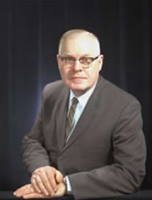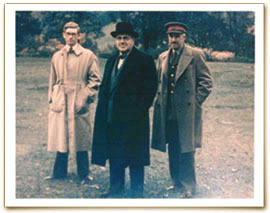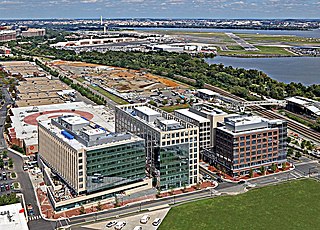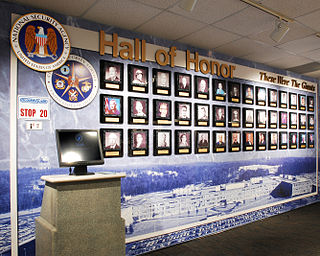Related Research Articles

The National Security Agency (NSA) is an intelligence agency of the United States Department of Defense, under the authority of the Director of National Intelligence (DNI). The NSA is responsible for global monitoring, collection, and processing of information and data for foreign and domestic intelligence and counterintelligence purposes, specializing in a discipline known as signals intelligence (SIGINT). The NSA is also tasked with the protection of U.S. communications networks and information systems. The NSA relies on a variety of measures to accomplish its mission, the majority of which are clandestine. The NSA has roughly 32,000 employees.

William Frederick Friedman was a US Army cryptographer who ran the research division of the Army's Signal Intelligence Service (SIS) in the 1930s, and parts of its follow-on services into the 1950s. In 1940, subordinates of his led by Frank Rowlett broke Japan's PURPLE cipher, thus disclosing Japanese diplomatic secrets before America's entrance into World War II.

Frank Byron Rowlett was an American cryptologist.

Louis William Tordella was the longest serving deputy director of the National Security Agency.

Agnes Meyer Driscoll, known as "Miss Aggie" or "Madame X'", was an American cryptanalyst during both World War I and World War II and was known as "the first lady of naval cryptology."

Clifford Christopher Cocks is a British mathematician and cryptographer. In the early 1970s, while working at the United Kingdom Government Communications Headquarters (GCHQ), he developed an early public-key cryptography (PKC) system. This pre-dated commercial offerings, but due the classified nature of Cocks' work, it did not become widely known until 1997 when the work was declassified.

Brigadier John Hessell Tiltman, was a British Army officer who worked in intelligence, often at or with the Government Code and Cypher School (GC&CS) starting in the 1920s. His intelligence work was largely connected with cryptography, and he showed exceptional skill at cryptanalysis. His work in association with Bill Tutte on the cryptanalysis of the Lorenz cipher, the German teleprinter cipher, called "Tunny" at Bletchley Park, led to breakthroughs in attack methods on the code, without a computer. It was to exploit those methods, at extremely high speed with great reliability, that Colossus, the first digital programmable electronic computer, was designed and built.

The National Cryptologic Museum (NCM) is an American museum of cryptologic history that is affiliated with the National Security Agency (NSA). The first public museum in the U.S. Intelligence Community, NCM is located in the former Colony Seven Motel, just two blocks from the NSA headquarters at Fort George G. Meade in Maryland. The motel was purchased, creating a buffer zone between the high security main buildings of the NSA and an adjacent highway. The museum opened to the public on December 16, 1993, and now hosts about 50,000 visitors annually from all over the world.

William Bolding Black Jr. is a former Deputy Director of the National Security Agency.

The Institute for Defense Analyses (IDA) is an American non-profit corporation that administers three federally funded research and development centers (FFRDCs) – the Systems and Analyses Center (SAC), the Science and Technology Policy Institute (STPI), and the Center for Communications and Computing (C&C) – to assist the United States government in addressing national security issues, particularly those requiring scientific and technical expertise. It is headquartered in Alexandria, Virginia.

Richard A. Leibler was an American mathematician and cryptanalyst. Richard Leibler was born in March 1914. He received his A.M. in mathematics from Northwestern University and his Ph.D. from the University of Illinois in 1939. While working at the National Security Agency, he and Solomon Kullback formulated the Kullback–Leibler divergence, a measure of similarity between probability distributions which has found important applications in information theory and cryptology. Leibler is also credited by the NSA as having opened up "new methods of attack" in the celebrated VENONA code-breaking project during 1949-1950; this may be a reference to his joint paper with Kullback, which was published in the open literature in 1951 and was immediately noted by Soviet cryptologists.
Michael Wertheimer is a cryptologic mathematician. From October 31, 2005, until June 2009, he was the assistant deputy director and chief technology officer of the Office of the Director of National Intelligence for Analysis. Wertheimer oversaw the coordination of Intelligence Community efforts to bring increased depth and accuracy to analysis through technology. He observed and catalogued the autostasis effect in 1968, which is the opposite of the autokinetic effect. In 2008, Wertheimer successfully launched A-Space, the U.S. Intelligence Community's "Facebook for Spies." This new social network opened in September 2008 for U.S. intelligence analysts and covert operatives across some 16 intelligence agencies to share information. He continues to advocate for reforms in the intelligence community and is currently involved in pressing for adopting Intellipedia, a classified wiki.

Dr. Lowell K. (Jim) Frazer was a mathematician who worked for the National Security Agency (NSA) in the field of cryptography.
Samuel Simon Snyder was a cryptographer for the United States Government. His pioneering work in early computers led directly to the development of the computer as we know it, and laid the foundation for many aspects of the modern computing industry. He is known for having broken every Japanese encrypted message with his partners in the Signal Intelligence Service during World War II and for having developed the MARC standards.
Howard C. Barlow (1918–2003) was an American cryptographer, telecommunications expert, and high-ranking civilian employee of the National Security Agency (NSA) of the United States.

The Hall of Honor is a memorial at the National Security Agency headquarters in Fort Meade, Maryland. It honors individuals who rendered distinguished service to American cryptology.
William Coffee (1917–1989) was an American cryptographer. He received the Commendation for Meritorious Civilian Service in April 1946 for his role in recruiting and leading a group of African-American cryptographers in the United States Army's Signals Intelligence Service. He began his career in public service with the Civilian Conservation Corps from 1937 to 1940. Soon after, he began working for the Signal Intelligence Service, later known as the Signal Security Agency. Despite being hired as a janitor, he was promoted to a messenger. Upon being promoted, he was assigned the task of hiring a group of black cryptologists at Arlington Hall Station. His success in composing and directing this group elevated him to a status previously unreached by black cryptologists. After the Second World War, Coffee joined the Armed Forces Security Agency, which later became the National Security Agency. Coffee retired from the NSA in 1972. He was inducted into the National Security Agency's Cryptologic Hall of Honor in 2011.

Dorothy Toplitzky Blum was an American computer scientist and cryptanalyst. She worked for the National Security Agency and its predecessors from 1944 until her death in 1980.
Minnie M. Kenny was a cryptanalyst, educator and equal opportunity activist who worked at the National Security Agency (NSA). She served as deputy commandant at the National Cryptologic School and was responsible for creating scholarships for NSA employees. The recipient of numerous awards, including the Meritorious and the Exceptional Civilian Service Awards, the presidential Meritorious Executive Award and Distinguished Service Award of the CIA, Kenny was inducted into the Cryptologic Hall of Honor in 2009.
Mahlon E. Doyle was an American cryptologist, inventor, innovator, and author. He enjoyed a three decade career at the National Security Agency and its predecessor organizations.
References
- ↑ "Richard C Proto" . Retrieved December 21, 2020.
- ↑ "Richard Proto".
- 1 2 "155 Cong. Rec. E1269 - Tribute To Richard Proto". Congressional Record. U.S. Government Publishing Office. Retrieved May 7, 2017.
- 1 2 3 4 "NSA Hall of Honor: Richard Proto". nsa.gov. United States National Security Agency. Retrieved May 7, 2017.
- ↑ "Patents by Inventor Richard C. Proto". patents.justia.com. Justia Patents. Retrieved May 7, 2017.